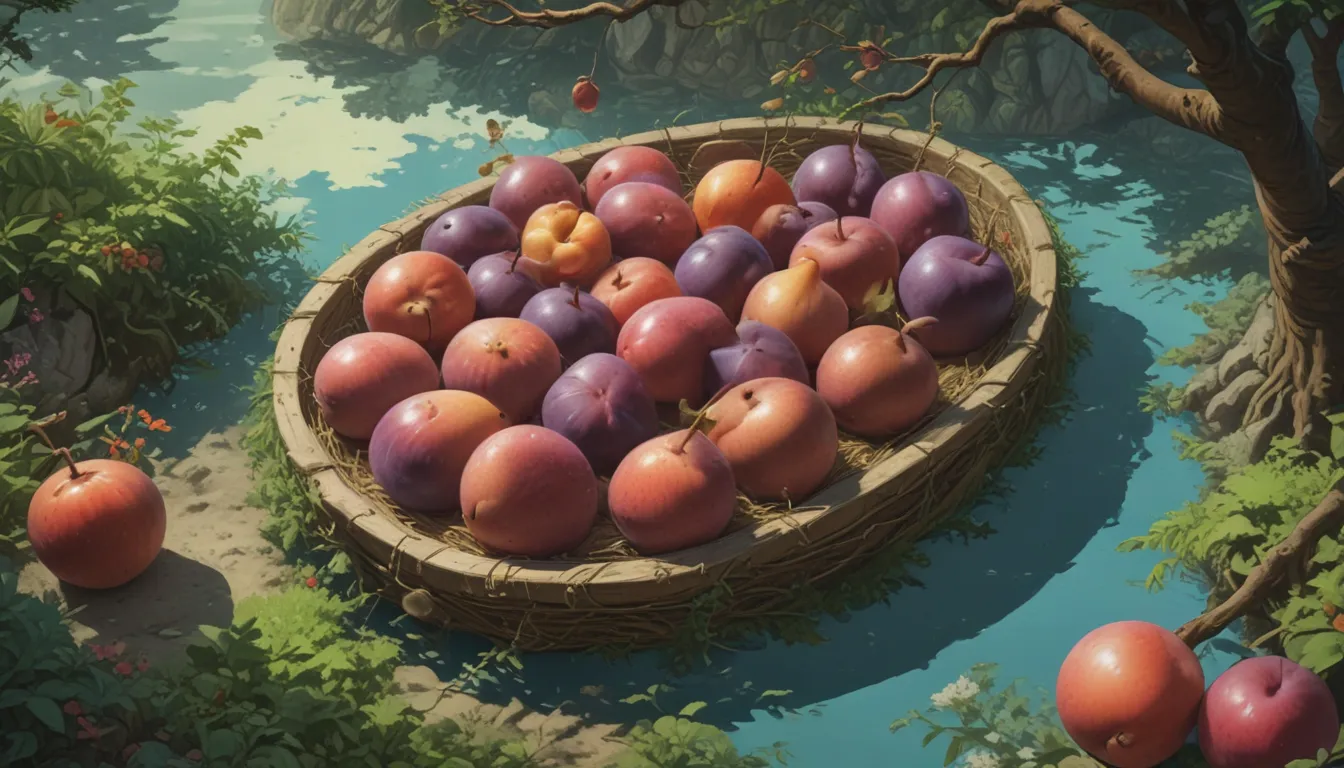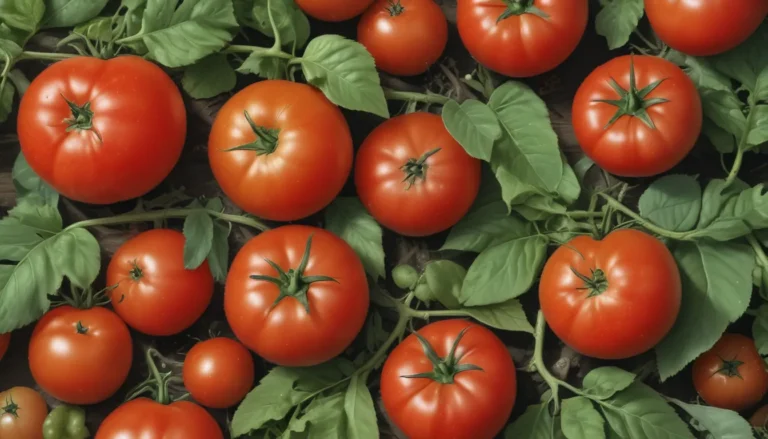Plumcots and Pluots: The Best of Both Worlds

Are you a fan of fusion dishes like East meets West on a plate or love a good hybrid read of science fiction mixed with mystery? Just like these delightful blends, in the fruit world, we have the plumcot and the pluot. These sensational hybrids bring together the nostalgic charm of plums and the sweet elegance of apricots to create a taste experience like no other.
In this in-depth article, we’ll explore the world of plumcots and pluots, sharing valuable information on cultivating these interspecific hybrid fruits in your own garden. So, join me in discovering the juicy secrets of these modern, high-performance hybrids that are sure to elevate your orchard game.
What You’ll Learn
- What Are Plumcots and Pluots?
- Cultivation and History
- Propagation
- How to Grow
- Growing Tips
- Pruning and Maintenance
- Cultivars to Select
- Managing Pests and Disease
- Harvesting
- Preserving
- Recipes and Cooking Ideas
- Quick Reference Growing Guide
Let’s dive into the fascinating world of plumcots and pluots and uncover how you can cultivate these extraordinary fruit trees in your own backyard.
What Are Plumcots and Pluots?
Plumcots and pluots are hybrids created by crossing cultivars of plums and apricots, both of which belong to the genus Prunus. Plumcots are a 50-50 mix of plums and apricots, while pluots lean more towards plums, typically containing 60 to 75 percent plum genes and 25 to 40 percent apricot genes.
The hybridization of these fruits has a rich history, with various species of plums and apricots coming together to create unique flavor profiles and textures in the resulting fruit. Japanese plums, known for their sweet flavor and juicy texture, are often used in modern hybridization efforts due to their desirability.
The process of creating plumcots and pluots has evolved over the years, with breeders like Luther Burbank and the Zaiger family pioneering different hybridization techniques. Modern pluots, popularized by the Zaiger family, involve complex cross-breeding to achieve fruits with specific characteristics in terms of flavor, texture, and appearance.
Plumcots and pluots are best suited for temperate climates, requiring a certain number of chilling hours during the winter to promote flowering in the spring. These trees typically thrive in USDA Hardiness Zones 5 to 9 and manifest a range of colors, shapes, and flavors, depending on the specific variety.
Cultivation and History
The commercialization of plumcots and pluots in America can be traced back to the pioneering work of Luther Burbank and the innovative breeding program of the Zaiger family. Burbank’s early experiments laid the foundation for future breeders to create hybrid fruits like the pluot, which found significant commercial success.
The Zaiger family, with their intricate hybridization techniques, developed numerous pluot varieties with unique flavors and textures, leading to the increased popularity of these fruits in grocery stores and farmers markets. As a result of their efforts, other hybrid fruits like the aprium were also created, offering a diverse range of flavor profiles to consumers.
The names “plumcot,” “pluot,” and “aprium” are often used interchangeably, but they each have distinct genetic makeup and breeding histories. These fruits are a testament to the possibilities of selective breeding and the ever-evolving world of fruit cultivation.
Plumcot and Pluot Propagation
Propagating plumcots and pluots can be done through grafting, cutting, or seed germination. While growing these hybrids from seed can be challenging and unpredictable, grafting scions onto specific rootstocks is a more reliable method to ensure fruit quality and characteristics.
Grafting involves taking a scion from the desired tree and attaching it to a rootstock, creating a union that results in identical fruit production to the parent plant. This method allows for increased disease resistance and other favorable traits to be passed on to the new tree.
Regardless of the propagation method chosen, it’s essential to ensure healthy plant materials and precise cuts to achieve successful grafts. For home gardeners, purchasing grafted trees from nurseries is generally the best option to guarantee healthy and reliable plumcot or pluot trees.
Transplanting these trees requires careful attention to spacing, soil preparation, and watering practices to ensure successful establishment. Incorporating beneficial fungi into the soil at planting can promote root health and nutrient absorption, essential for the tree’s initial growth.
How to Grow Plumcots and Pluots
Plumcots and pluots thrive in full sun, preferring south-facing or west-facing locations with well-draining soil and a pH range of 6.0 to 7.0. Sheltered sites that protect the trees from prevailing winds are ideal for optimal growth.
To promote cross-pollination and fruit production, planting another pluot or Japanese plum nearby is recommended. Regular watering, mulching, and fertilizing based on growth observations are essential to ensure healthy and vigorous tree development.
Pruning and maintenance are crucial aspects of plumcot and pluot care, requiring annual pruning to maintain a healthy structure, promote fruit production, and prevent disease. Thinning fruit and cleaning up fallen debris are essential tasks to ensure quality harvests and reduce the risk of pests and diseases.
Growing Tips
- Choose a sheltered location with full sun.
- Plant in well-draining soil with a pH of 6.0-7.0.
- Amend the soil with organic matter to enhance fertility.
- Plant another pluot or Japanese plum to promote cross-pollination.
Plumcot and Pluot Cultivars to Select
When selecting plumcot and pluot cultivars for your garden, consider regional climate conditions, chilling hour requirements, and pollination needs. Popular varieties like Dapple Dandy, Flavor King, Flavorella, Geo Pride, and Splash offer unique flavors and characteristics suited for different zones.
Consult local nurseries or agricultural extensions for advice on the best varieties for your region, taking into account chilling requirements and pollination compatibility. Orchardists can benefit from the ornamental value of these trees, with fragrant spring blooms attracting bees and butterflies.
Managing Pests and Disease
Managing pests and disease is essential to ensure successful fruit production in plumcots and pluots. Herbivores like deer, mice, rats, and rabbits can damage trees, while insects such as aphids, borers, and scale can pose threats to fruit and foliage.
Regular monitoring and early intervention are key to controlling pest populations and preventing disease outbreaks. Good sanitation practices, like cleaning up fallen fruit and leaves, can reduce the risk of infestations and infections.
Harvesting and Storage
Plumcots and pluots are typically ready for harvest from mid-June to early July, with some varieties extending the season into fall. Harvest when fruits are plump, firm, and exhibit rich coloration, ensuring optimal ripeness for consumption.
Proper storage of harvested fruits in a cool, humid environment between 32 and 40°F can extend their shelf life for up to three weeks. Freezing sliced fruit can preserve them for up to eight months, making them accessible for winter use in various culinary applications.
Recipes and Cooking Ideas
Plumcots and pluots are versatile fruits that can be enjoyed fresh, processed into jams, jellies, or dehydrated into fruit leather. From summer salads to baked galettes, these fruits lend themselves well to a variety of culinary creations, adding sweetness and flavor to dishes.
Experiment with different recipes and cooking styles to showcase the unique qualities of plumcots and pluots, creating delightful dishes that highlight their rich texture and taste. Whether eaten fresh, preserved, or integrated into savory dishes, these hybrid fruits offer endless culinary possibilities.
Conclusion
Plumcots and pluots embody the perfect fusion of plums and apricots, creating a harmonious blend of flavors and textures in one exceptional fruit. By understanding their cultivation, history, propagation, and care requirements, you can successfully grow these high-performance hybrids in your own garden.
Explore the diverse range of cultivars available, select varieties suited for your region, and follow best practices for planting, maintenance, and harvest to enjoy a bountiful harvest of plumcots and pluots. Embrace the possibilities of selective breeding and the ever-evolving world of fruit cultivation through these perfectly orchestrated duets in your orchard.
Let the magic of plumcots and pluots transform your garden into a thriving orchard of flavor and fragrance. Share your plumcot and pluot growing experiences, cultivar choices, and culinary creations in the comments below. Let’s embark on this fruit-filled journey together!
For more information on growing food-producing trees and orchard care, check out our related articles:
- What Are Fruit Tree Guilds? Learn How to Start Your Own
- Winter and Summer Pears: What’s the Difference?
- How to Grow and Care for Braeburn Apple Trees
Let’s cultivate happiness and flavor together in our orchards! 🌳🍑🌿🍴
*Photos by Tabitha Caswell





